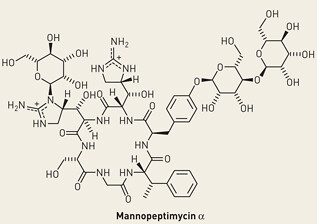I originally posted this over two years ago. Moral of the story--don't believe every breathless medical breakthrough drug development story you read. (and if it were really good, they wouldn't be telling anyone about it):
From Chemical and Engineering News:
Enter The Mannopeptimycins: New class of antibiotics offers hope in treating resistant infections by Bethany Halford
Mannopeptimycins, a family of antibiotics recently mined from a decades-old research effort, could give doctors the weapon they've been looking for in the fight against antibiotic-resistant infections. The compounds feature a novel cyclic peptide structure and a biochemical mechanism that's distinct from other antibiotics.
Although it's still in the early stages of discovery, the promising new class of potent anti-infective agents has shown in vitro and in vivo activity against deadly bacteria, such as methicillin-resistant staphylococci and vancomycin-resistant enterococci. Frank E. Koehn, a scientist with Wyeth Research in Pearl River, N.Y., spoke on March 29 about the chemical and biological strategies used to discover this complex family of natural products during a Division of Organic Chemistry symposium at the ACS national meeting in Atlanta.Scientists first came across mannopeptimycins in the late 1950s, during a research effort at Lederle Labs to discover new antibiotics. The project yielded a curious collection of compounds, dubbed AC98, that was produced by a strain of Streptomyces hygroscopicus and showed activity against gram-positive bacteria.
Despite its promising antibiotic properties, AC98 was put into cold storage. "The technical challenge of elucidating the chemical structures was just too daunting with the technology that was available in the 1950s," Koehn explained. Also, AC98 wasn't active against all bacteria, and scientists were looking for broad-spectrum antibiotics at that time.
"That was good thinking back then," Koehn said. "But a regrettable result was that the widespread use of these antibiotics brought about bacterial resistance to antibiotics."
Fast-forward 40 years. To fight the growing problem of antibiotic resistance, researchers at Wyeth, with which Lederle had merged, began mining their old antibacterial research. Using what remained of the AC98 project, and applying the modern techniques of chromatography and nuclear magnetic resonance spectrometry, Wyeth scientists were able to separate the complex mix of compounds and elucidate their structures.
The compounds they discovered, known as the mannopeptimycins, are glycosylated cyclic hexapeptides that contain both stereoisomers of the unusual amino acid beta-hydroxyenduracididine. They also feature an unusual N-glycosidic bond, which links a mannose sugar to one of the beta-hydroxyenduracididine residues. "There aren't a lot of structures like it," Koehn said.
The Wyeth group also found that the compounds showed remarkable activity against strains of bacteria that powerful antibiotics couldn't touch. That, Koehn said, became the driving force behind a joint effort of natural products chemists and medicinal chemists to generate potent mannopeptimycins for further development. By combining their knowledge of structure-activity relationships and the mannopeptimycins' biosynthetic pathway, the researchers have created an optimized molecule with improved in vivo activity.
The compound is still a long way from becoming a viable antibiotic therapy, Koehn says, but the work they've done shows that natural products are still a good source of therapeutic agents. The combined efforts of natural products and medicinal chemists can produce some potent molecules, he added. "We think it's an important story."
This sounds promising, although there's probably a Streptomyces out there that's already resistant-even to the altered mannopeptimycins...


Well heck, the mannopeptimycins are natural products. Still, they might be useful *if used judiciously* and not, perhaps, routinely fed to pigs and chickens to improve weight gain.